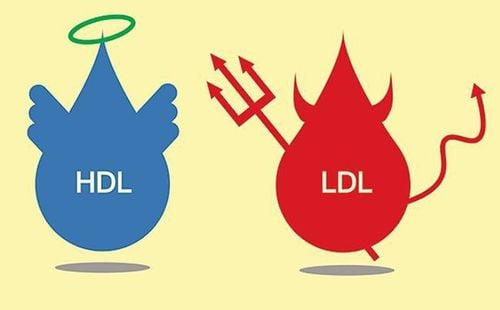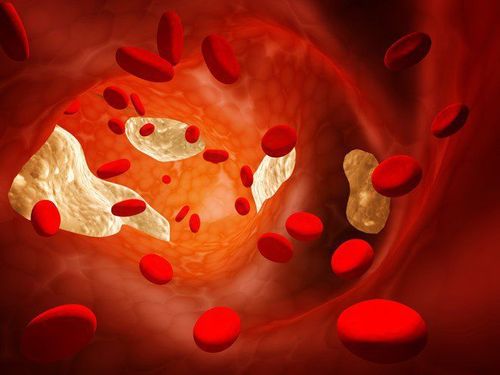This is an automatically translated article.
The article was professionally consulted by Doctor Nguyen Thai Ngoc Chau - Department of Pediatrics - Neonatology, Vinmec Phu Quoc International General Hospital.Many people don't realize that the problems caused by high blood cholesterol can start in childhood. The condition is likely to continue to develop from growth spurts through adolescence and into adulthood. High cholesterol in children increases the risk of related diseases for children.
1. The dangers of high blood cholesterol
Children's bodies need some cholesterol to protect their nerves. Tissue formation and production of certain hormones. But too much cholesterol damages blood vessels. By attaching to and forming atherosclerotic clumps in the vessel wall. Studies show that these plaques are likely to form in childhood and are more likely to form in children with high blood cholesterol levels. High cholesterol levels increase the risk of heart disease and stroke. Cardiovascular disease is the leading cause of death in the United States. The risk is increased in people with a family history of heart disease, people with diabetes, overweight or obesity, people with unhealthy eating habits, a sedentary lifestyle, and smokers. Talk to your doctor about whether your child needs a cholesterol test.2. Where does cholesterol come from?
The liver makes cholesterol to meet the body's needs. However, we also absorb cholesterol from the foods we eat every day, including animal foods like eggs, meat, and dairy products.What is the difference between an LDL level and an HDL level?
Cholesterol moves in the blood thanks to different building blocks of molecules, called Lipoproteins. Low-density lipoprotein (LDL) transports cholesterol to cells. That is why they are considered “bad” cholesterol. Some people are prone to synthesizing more LDL cholesterol. In addition, eating foods high in saturated fat, trans fat or cholesterol also increases the amount of LDL in the blood. High-density lipoprotein (High-density lipoprotein) separates cholesterol from the blood. They are considered “good” cholesterol. The right amount of HDL will help protect the body from cardiovascular disease. Exercise helps the body increase the production of HDL. Avoiding trans fats and following a healthy diet also helps raise HDL levels.
This explains why too much LDL cholesterol is bad for the body and more HDL is better. When looking at total cholesterol, one should consider the balance between the ingredients. If high total cholesterol is due to high levels of LDL, the subject's risk of cardiovascular disease or stroke is higher. Conversely, if high levels of HDL are responsible for high total blood cholesterol, then the risk may not increase.

3. Causes of high cholesterol in children
In children aged 5-12, high blood cholesterol levels are mainly caused by three factors:Genetic factors: Children can inherit genes (high blood cholesterol levels) from their parents and this also is the most common cause of high blood cholesterol in most cases. Diet for children is not reasonable and healthy: Children have a diet rich in fat, especially saturated fat and trans fat. Childhood obesity: It is linked to an unhealthy diet and lack of exercise. High levels of cholesterol in the blood will not have any symptoms and only with blood tests or when it turns into dangerous diseases can it be noticed. Therefore, parents need to determine their own cholesterol levels, if parents have high blood cholesterol levels or children show signs of being overweight, parents should take their children to be checked to avoid unfortunate complications.
4. How to know if your child has high cholesterol?
To check cholesterol levels, the doctor will order a "Blood fat test". This screening is usually only done when there is a family history of high cholesterol or the child has diabetes.What cholesterol level in children is appropriate?
If the doctor orders a "blood fat test", you should ask what cholesterol level is appropriate for the age and development of the child. The American Academy of Pediatrics general recommendations for cholesterol levels for children and adolescents 2-19 years of age are as follows:
Total cholesterol (mg/dL)
Acceptable: <170 Limit: 170-199 High: >= 200 LDL Cholesterol (mg/dL)
Acceptable: <110 Limit: 110-129 High: >=130

5. Does the child have to take medicine to reduce the amount of cholesterol in the blood?
If a child is determined to have high cholesterol, and diet and exercise do not help lower cholesterol, especially for a child with diabetes, overweight or obesity, then the doctor will prescribe cholesterol-lowering drugs. Not all medicines are safe for children, so do not give them to your child without your doctor's approval.6. Help your baby prevent high cholesterol levels
Maintain an age-appropriate weight and change your child's dietGive your baby at least five servings of fruits and vegetables a day. For example, healthy snacks like apples, bananas, carrots, celery. Cook meals high in low-fat protein, vegetables, and whole grains. Avoid giving your baby saturated and trans fats. Saturated fats are commonly found in animal products (eg meat and eggs) and dairy products (eg cheese and butter). Many snack foods (such as cookies and chips) are high in saturated fat. Trans fats are commonly found in processed foods (eg, donuts and cookies) and fried foods (eg, french fries and onion rings). Avoid eating fast food. If your child has to eat at a fast food joint or restaurant, choose the healthiest options possible. Limit your child's time watching TV, computer, cell phone or gaming to no more than 1-2 hours per day. Set an example for your child by limiting screen time yourself. Encourage your child to find physical activity he enjoys and be active regularly. Get your baby active for at least 1 hour a day. Encourage children to play movement games that they enjoy. The whole family should participate in group activities such as walking, cycling, bowling. Encourage the whole family to practice sports. Take a walk, bike ride or do chores together. You can also plan a picnic for the whole family As a key area of Vinmec Health system, Pediatrics always brings satisfaction to customers and is highly appreciated by industry experts with:
Gathering a team of leading doctors and nurses in Pediatrics: including leading experts, highly qualified (professor, associate professor, doctorate, master), experienced, worked in big hospitals like Bach Mai, 108.. The doctors are all well-trained, professional, have a heart - reach, understand young psychology. In addition to domestic pediatric specialists, the Department of Pediatrics also has the participation of foreign experts (Japan, Singapore, Australia, USA) who are always pioneers in applying the latest and most effective treatment regimens. . Comprehensive services: In the field of Pediatrics, Vinmec provides a series of continuous medical examination and treatment services from Newborn to Pediatric and Vaccine,... according to international standards to help parents take care of their baby's health from birth to childhood. from birth to adulthood Specialized techniques: Vinmec has successfully deployed many specialized techniques to make the treatment of difficult diseases in Pediatrics more effective: neurosurgery - skull surgery, stem cell transplantation. blood in cancer treatment. Professional care: In addition to understanding children's psychology, Vinmec also pays special attention to the children's play space, helping them to have fun and get used to the hospital's environment, cooperate in treatment, improve the efficiency of medical treatment.
Please dial HOTLINE for more information or register for an appointment HERE. Download MyVinmec app to make appointments faster and to manage your bookings easily.














